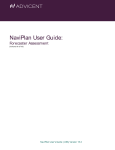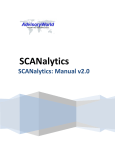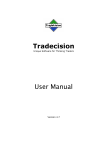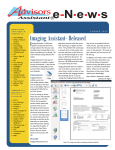Download NaviPlan User Manual: Introduction
Transcript
NaviPlan User Manual: Introduction (Volume I of IV) NaviPlan User's Guide: (USA) Version 14.2 Copyright and Trademark © Copyright 2013-2014 Advicent LP and its affiliated companies (Advicent). All rights reserved. Advicent® and NaviPlan® are trademarks of Advicent. No part of this publication may be reproduced or transmitted in any form, by any means (electronic, photocopying, recording, or otherwise) without the written permission of Advicent. Microsoft Word is a registered trademark of Microsoft Corporation. Adobe and Acrobat are trademarks of Adobe Systems Inc. All other product names are the sole properties of their respective owners. Software License This publication is intended for use by authorized licensees of Advicent’s proprietary NaviPlan software described herein. This publication does not grant any license or right to use of the software, and use of the software or this publication is prohibited by anyone who is not an authorized licensee. All licenses, rights, and restrictions on use of the software are governed by a separate license agreement. Disclaimer The software described in this publication is designed to allow a financial planner to demonstrate and evaluate various strategies in order to achieve a client’s financial goals. It is licensed to authorized licensees on the understanding that Advicent is not engaged in rendering legal, accounting, or other professional advice and, if any such advice is required, the services of a competent professional person should be obtained. Advicent has engaged Ibbotson Associates, Inc., a wholly owned subsidiary of Morningstar, Inc., to develop proprietary asset allocation tools for educational purposes. Ibbotson has granted to Advicent a license for use thereof. USA version 01/07/2014 NaviPlan User Manual: Introduction Contents Contents 3 Chapter 1: Using this manual 7 NaviPlan User Manual Series 8 Conventions 9 NaviPlan Resources 10 Phone support 10 Chapter 2: Overview of NaviPlan 11 About NaviPlan 12 Recommended steps 13 About client files, engagements, and plans 15 Easy-to-use planning levels 16 Calculators 16 Financial Assessment 16 Asset Allocation Assessment 16 Level 1 Plan 17 Level 2 Plan 18 Chapter 3: Entering and managing client information 19 Collecting financial information 21 Using the Blank Fact Finder 21 Creating a client file 22 Entering a new client file manually 22 Creating client files in the Presentation Module 28 Working with a new client 28 Working with an existing client 28 Entering financial data using presentations 29 Navigating through a presentation 29 Printing a presentation 29 Page 3 of 88 NaviPlan User Manual: Introduction Switching to NaviPlan 29 Accessing NaviPlan calculators and reports 30 Importing data into NaviPlan 31 Selecting sources for data integration 31 Importing client information into a client file 32 Importing updated information for existing clients 33 Managing existing client files 34 Opening an existing client file 34 Updating clients’ personal information 35 Preparing client files for delivery to third parties 35 Deleting a client file 36 Checking client files in and out of a central database in NaviPlan Offline 37 Checking out a client file 37 Undoing a check-out without making changes 38 Checking in a client file to a central database 38 Checking multiple client files in and out 39 Viewing a client file in the database 39 Granting and revoking access to your client files 39 Managing engagements 41 Creating a new engagement 41 Opening and deleting existing engagements 42 Working with calculators, assessments, and plans 43 Creating a calculator, an assessment, or a plan 43 Using compliance-based workflow in NaviPlan 44 Submitting an assessment or a plan for review 45 Reviewing an assessment or a plan 47 Reviewing assessments and plans for several clients (online) 47 Creating an update plan 48 Chapter 4: Setting user preferences 51 Page 4 of 88 NaviPlan User Manual: Introduction Entering advisor details 53 Setting system preferences 54 Changing passwords in NaviPlan Online 54 Selecting Sources for Data Integration 55 Setting import and data storage locations 56 Deleting report templates 56 Choosing report formats 57 Setting plan preferences 59 Entering general preferences 59 Entering client milestones 60 Entering Social Security assumptions 60 Setting portfolio balancing preferences 61 Entering retirement cash flow assumptions 63 Entering net worth assumptions 64 Entering education assumptions 65 Entering insurance assumptions 66 Setting asset allocation defaults (with user-defined asset allocation) 67 Setting default asset classes 67 Setting default correlation values 68 Setting default investor profiles 68 Setting default portfolios 70 Setting security preferences in NaviPlan Offline 71 Authorizing NaviPlan 71 Transferring your authorization between computers 72 Configuring your USB drive 72 Preparing your home computer 74 Transferring authorization from your work computer 74 Transferring authorization to your home computer 76 Transferring authorization back to your work computer 76 Page 5 of 88 NaviPlan User Manual: Introduction Removing your authorization 77 Viewing the status of your authorization 78 Index 79 Page 6 of 88 NaviPlan User Manual: Introduction Chapter 1: Using this manual The NaviPlan user manual series includes all the instructions you need to use NaviPlan effectively. This chapter will help you use all the manuals in this series. More manuals are available on the Learning Center. In this chapter: NaviPlan User Manual Series 8 Conventions 9 NaviPlan Resources 10 Page 7 of 88 NaviPlan User Manual: Introduction NaviPlan User Manual Series NaviPlan user manuals are organized by the tasks you can accomplish in each level. If you are a new NaviPlan user, start with the Introduction user manual. User manual Introduction Calculators and Assessments Level 1 and Level 2 Plans – Entering client data and goals Level 1 and Level 2 Plans – Analyzing client goals Tasks covered n Setting up user preferences. n Creating and managing client engagements. n Determining which assessment or plan level to select. n Using NaviPlan workflow. n Using calculators to model specific aspects of your clients’ finances. n Assessing your clients’ current financial situation. n Entering account and annuity information. n Determining your clients’ investor profile. n Entering financial planning assumptions. n Entering detailed net worth, cash flow, and insurance information. n Adding holdings to accounts and annuities. n Entering business entities. n Entering real estate assets. n Entering equity compensation. n Entering detailed estate planning information. n Entering advanced estate planning information. n Using the Detailed Tax method and Detailed Cash Flow . n Entering saving and redemption strategies. n Entering client goals. n Generating simple estate planning reports. n Generating client reports. n Analyzing your clients’ goals using Scenario Manager. n Conducting detailed cash flow and net worth analyses. n Generating Monte Carlo simulations. n Creating goal scenarios. n Creating estate planning scenarios. n Generating client reports. Page 8 of 88 NaviPlan User Manual: Introduction Conventions This user manual uses the following conventions. n The names of items on the screen are bolded and italicized. For example, the Clients page opens. n The names of items that you must select, click, or enter appear in bold. For example, select Recommended, and then click OK. n To help you navigate through the application, locations are separated by en dashes (–). For example, Enter Financial Data section – Net Worth category – Accounts page. Enter Financial Data section – Net Worth category – Accounts page To help you use this manual, please note the following abbreviations and graphics: n AA – Refers to the Asset Allocation Assessment. n FA – Refers to the Financial Assessment. n – Indicates that the step or paragraph applies to Level 1 Plans only. n – Indicates that the step or paragraph applies to Level 2 Plans only. n – Indicates that the step or paragraph only applies when you are using the Average Tax method. n – Indicates that the step or paragraph only applies when you are using the Detailed Tax method. Page 9 of 88 NaviPlan User Manual: Introduction NaviPlan Resources Advicent provides several resources to help you use NaviPlan. The following table shows some of the resources available and where to find them. Advicent resource Description and location Help The quickest way to get information about any item within NaviPlan is to use the application Help. To access Help, select NaviPlan Help from the Help & Resources menu. Help includes a glossary of terms. Functional documents Functional documents explain NaviPlan functionality, underlying assumptions, and results calculations. You can access functional documents from the NaviPlan Learning Center. Quick Reference Guides (QRGs) Quick Reference Guides are designed to get you started with a particular workflow in NaviPlan. You can access QRGs from the NaviPlan Learning Center. User Manuals You can also access other user manuals in this series . You can access manuals from the NaviPlan Learning Center. Help Videos Help videos are designed to give you an overview of each section in NaviPlan. You can access help videos from the NaviPlan Learning Center. Phone support You can contact us by telephone at (888) 692-3474 (Monday–Thursday, 7:30 a.m.–6 p.m. central time) (Friday, 7:30 a.m.-5:00p.m. central time) Page 10 of 88 NaviPlan User Manual: Introduction Chapter 2: Overview of NaviPlan This chapter provides a general overview of NaviPlan: In this chapter: About NaviPlan 12 Recommended steps 13 About client files, engagements, and plans 15 Easy-to-use planning levels 16 Page 11 of 88 NaviPlan User Manual: Introduction About NaviPlan NaviPlan is a goals-based financial planning tool. You define your clients’ goals, and NaviPlan helps you determine if they are attainable, given the clients’ income, savings, and spending. NaviPlan includes different levels of data entry so that you can create an assessment or plan that best meets your clients’ financial situation. If needed, you can model specific aspects of your clients’ finances, such as retirement savings and debt management, using NaviPlan’s calculators. If your clients have diversified financial situations that require a more comprehensive analysis, you can use the Detailed Tax method along with the Detailed Cash Flow module. This advanced planning option also provides access to the following additional advanced modules: Equity Compensation, Business Planning, and Advanced Estate. When using NaviPlan, with or without the Detailed Tax method, once all of your clients’ information has been entered, you can use the tools within NaviPlan, such as scenarios and reports, to analyze whether your clients will be able to achieve their goals. Based on the information entered, NaviPlan assesses each goal’s attainability and suggests strategies such as additional savings. In plans, you can enter strategies within scenarios to create an optimal solution to meet your clients’ goals. If you are working in an assessment and you want to create scenarios, you will need to promote the assessment to a plan. Because of its importance to a financial plan, NaviPlan calculates the clients’ cash flow each year. It also provides several resources such as indicators and graphs within scenarios that monitor the clients’ cash flow when implementing strategies to help you ensure that any recommendations are result in a positive cash flow. Once the assessment or plan is complete and you are satisfied with the results, you can incorporate all your recommendations into a single, professional, document. Page 12 of 88 NaviPlan User Manual: Introduction Recommended steps The process below outlines some recommended steps for creating an optimal plan for your clients. 1. Gather data n Use the Blank Fact Finder, to collect financial information from clients. It is available in NaviPlan in the Client Management section – Client List – Clients. n Collect appropriate documentation from your clients (e.g., income tax return, statements of employer-sponsored pension plans, most recent brokerage statements, personal budget, current mortgage and loan details). 2. Create the client file n Once all the financial data is collected, create a client file. You only need to create one client file for each client family. All future plans for that client will be saved within the same client file. n Enter demographic information for each family member. 3. Create a Financial Assessment n Create a Financial Assessment, which will take about five minutes, to engage clients and prospects. n Identify the clients’ current financial situation. n Quickly address clients’ concerns on retirement, education, major purchases, and insurance needs. 4. Analyze the clients’ asset allocation n If applicable, review the clients’ current asset allocation using an Asset Allocation Assessment. n Enter additional details about the clients’ current accounts and individual holdings. n Determine the clients’ risk tolerance and create a proposed asset allocation for their investor profile. 5. Enter financial information n If needed, enter clients’ financial information in a Level 1 or Level 2 Plan. The original plan contains current information for point of reference. Once completed, the original plan should not be altered. n Enter current net worth and cash flow information such as lifestyle assets, investment accounts, expenses, and incomes. n Enter current strategies for savings, debt modification, surplus savings/surplus expenses, and strategies. 6. Verify information n Ensure that the data is accurate, as any errors can alter results. The Synopsis report is especially useful for auditing your data. n Use the Planning Assistant to review problems, questions, and opportunities. Its reports provide information on cash flow surpluses and deficits that may exist in pre-retirement, as well as on unused contribution room, and overcontributions to qualified accounts. n Generate net worth and cash flow reports. Page 13 of 88 NaviPlan User Manual: Introduction 7. Define goals n Establish your clients’ plan objectives. NaviPlan’s predefined categories cover retirement, education, major purchase, and emergency fund goals, as well as survivor income, disability income, long-term care, and Monte Carlo analysis. 8. Analyze and solve for goals n Once all financial data and goals have been entered and verified, explore various scenarios as needed, and then implement the most effective planning strategies in the Recommended Plan scenario. Ensure that the selected recommendations are appropriate for your clients. For example, does their cash flow support the recommendations? 9. Present options n Present possible options to your clients using the Results section – Analyze Goals – Scenarios, and then confirm the strategies you will use. 10. Finalize and present the client report n Generate predefined client reports. These reports contain a series of graphs and customized text. You can choose from several client reports. Page 14 of 88 NaviPlan User Manual: Introduction About client files, engagements, and plans Before you begin to enter client data, you should understand how client files, engagements, and plans relate to each other. Client files, engagements, and plans are nested within each other. That is, a client file contains engagements; engagements contain plans, assessments, and calculators. Client file, engagement, and plan relationship Here are a few things to keep in mind when working with client files, engagements, and plans. n When you create a client file, NaviPlan automatically creates an engagement, as well as a plan, assessment, or calculator. n When you create an engagement, NaviPlan automatically creates a plan, assessment, or calculator. n Although you can create a calculator at any time, you cannot save a calculator until you create a client file. n You cannot delete an engagement until you delete all plans, assessments, and calculators in the engagement. n You cannot delete a client file until you delete all engagements in the file. Page 15 of 88 NaviPlan User Manual: Introduction Easy-to-use planning levels In NaviPlan, you can enter your clients’ financial information in four easy-to-use levels of data entry: Financial Assessments, Asset Allocation Assessments, Level 1 Plans, and Level 2 Plans. Note: If after creating a Financial Assessment, Asset Allocation Assessment, or Level 1 Plan, you require an additional level of data entry, you do not need to re-enter the data. Instead, you can promote the assessment or plan to a higher level. Calculators are a one-off analysis, so the financial data entered in a calculator does not carry over to other planning levels. Calculators n Provide a quick snapshot of one aspect of your clients’ financial situation. Financial Assessment n Enter a simple financial picture (high-level net worth and cash flow information). n Enter retirement, education, and major purchase goals. n Analyze life and disability insurance needs. n Generate a Financial Needs Assessment client report. Asset Allocation Assessment n Enter account and annuity information (with or without holdings). n Establish the clients’ risk tolerance. n Determine appropriate investment profiles using the Weightings and Optimize functions. n Propose an asset allocation that is appropriate to the clients’ investor profile. n Compare the current asset mix to the suggested asset mix. n Compare the expected rate of return and expected standard deviation for current and suggested asset mixes. n Generate an Asset Allocation client report. There are two plan types: Level 1 and Level 2. Within these plan types, you can create What-If Scenarios to compare possible financial strategies instead of creating additional plans for your clients. Page 16 of 88 NaviPlan User Manual: Introduction Level 1 Plan Level 1 Plans contain the same details as a Financial Assessment, plus n If the Asset Allocation module is included in the plan, you can o Define the investor profile and override it at the plan and goal levels. o Reallocate portfolio assets to match the investor profile at the plan date, and at first retirement. n Enter financial picture information with additional details. n Enter account information (with or without holdings). n Conduct a side-by-side comparison of the Current Plan and Recommended Plan scenarios (you can also modify or create additional scenarios). Note: The Current Plan scenario contains the clients’ current financial picture. A Recommended Plan scenario is a What-if scenario that includes alternative strategies the clients could implement. n Enter emergency fund goals. n Analyze survivor income, disability income, and long-term care goals. n Use the Planning Assistant™ to simplify the planning process. n Import external data. n Generate the Financial Needs Summary and Retirement Distribution Summary client reports. Note: The Asset Allocation client report is available only when the Asset Allocation module is included in the plan. n Generate additional reports and graphs if needed. Page 17 of 88 NaviPlan User Manual: Introduction Level 2 Plan Level 2 Plans contain the same details as a Level 1 Plan, plus n Override weightings for the investor profile allocations, access mean variance optimization, access the asset classifier database to allocate holdings, and at the goal level, and define different allocations and investor profiles. n Enter real estate assets. n Conduct Monte Carlo simulations. n Conduct Human Life Value analyses. n Generate estate planning reports (when using the Estate Planning module). n Generate the Financial Needs Analysis client report in addition to the reports available in a Level 1 plan. Note: The Asset Allocation client report is available only when the Asset Allocation module is included in the plan. n Enter detailed estate planning information (when using the Advanced Estate module). n Conduct detailed cash flow and net worth analyses (when using the Detailed Cash Flow module). n Conduct stock option and restricted stock analyses (when using the Equity Compensation module). n Conduct business planning analyses (when using the Business Planning module). The following table shows the available client reports for each level of data entry: Level Asset Allocation Financial Assessment Financial Needs Assessment Financial Needs Summary Retirement Distribution Summary Financial Needs Analysis x Asset Allocation Assessment x Level 1 Plan x x x x Level 2 Plan x x x x x Page 18 of 88 NaviPlan User Manual: Introduction Chapter 3: Entering and managing client information In NaviPlan, all information is stored within client files. You should create one client file for each client or client family. Before creating a client file, you can use a Blank Fact Finder to collect your clients’ financial information. Each client file you create is automatically assigned to you. Only you, and people with administrative access to your files, can work with your client files. However, in NaviPlan Online you can choose to give someone else access to your client files. You can also revoke that access at a later time. In this chapter: Collecting financial information 21 Using the Blank Fact Finder 21 Creating a client file 22 Entering a new client file manually 22 Creating client files in the Presentation Module 28 Importing data into NaviPlan 31 Managing existing client files 34 Opening an existing client file 34 Updating clients’ personal information 35 Preparing client files for delivery to third parties 35 Deleting a client file 36 Checking client files in and out of a central database in NaviPlan Offline 37 Checking out a client file 37 Undoing a check-out without making changes 38 Checking in a client file to a central database 38 Checking multiple client files in and out 39 Viewing a client file in the database 39 Granting and revoking access to your client files 39 Managing engagements 41 Creating a new engagement 41 Opening and deleting existing engagements 42 Working with calculators, assessments, and plans 43 Creating a calculator, an assessment, or a plan 43 Page 19 of 88 NaviPlan User Manual: Introduction Using compliance-based workflow in NaviPlan 44 Submitting an assessment or a plan for review 45 Reviewing an assessment or a plan 47 Reviewing assessments and plans for several clients (online) 47 Creating an update plan 48 Page 20 of 88 NaviPlan User Manual: Introduction Collecting financial information Before entering your clients’ financial information into NaviPlan, collect all the clients’ relevant financial documents. These include the following: n Tax returns and assessments for the client and co-client for the past two years. n Social Security Statements. n Pension statements and booklets from the client’s and co-client’s employers. n Benefits statements from the client’s and co-client’s employers. n Pension statements, investment plans, and benefits plans from former employers. n Pay stubs for the last two pay periods. n Life, disability, and long-term care insurance policies. n Most recent investment statements from banks, trust companies, brokers, and investment companies. n Budget of personal and living expenses. n Most recent mortgage and loan statements. n Most recent will and power of attorney documents. n Marital agreement(s). n Severance pay documents. n Any other relevant documents. Using the Blank Fact Finder You can use a Blank Fact Finder to collect your clients’ financial information. The Blank Fact Finder lists the information you need to collect, and provides space to record that information. Once collected, the information can be entered into NaviPlan. To print a Blank Fact Finder for a Level 2 Plan, follow these steps: 1. Go to the Client Management section – Client List category – Clients page, and then click Blank Fact Finder above the list of client files. A Fact Finder opens as a PDF file (or as an RTF file if you are able to change your settings accordingly). 2. Click Print, or go to the File menu and then select Print. Page 21 of 88 NaviPlan User Manual: Introduction Creating a client file Clients’ personal and financial information (including their calculators, assessments, and plans) are stored in client files. Once you have entered your clients’ personal information into a client file, it is available in all assessments and plans you create for the clients. There are three ways to create a client file: n Enter client information manually in NaviPlan (for more information, Entering a new client file manually below). n Enter client information collaboratively using the Presentation Module (for more information, Creating client files in the Presentation Module on page 28). n Import client information into a client file (for more information, see "Importing client information" on page 1). Entering a new client file manually To create a new client file without imported information, follow these steps: 1. Go to the Client Management section – Client List category – Clients page. 2. Click the Create New Client button and enter the required information. Client & Plan Creation dialog box – Client Information stage 3. Click Next. Page 22 of 88 NaviPlan User Manual: Introduction Client & Plan Creation dialog box – Family Members container 4. Enter the required information. n Click Add Family Member to add a new data-entry row. n To enter additional information for each family member, select the applicable n Family members entered here are automatically included as beneficiaries in the clients' estate. button. 5. Click Next. Client & Plan Creation dialog box – Beneficiaries stage 6. Enter the required information. n NaviPlan automatically creates a beneficiary named Other that is neither an heir nor a charity, but accounts for the annual gift tax exclusion. You cannot delete or edit the Other beneficiary. n Enter additional beneficiaries who are not family members. Using the Add Beneficary button. 7. Click Next. Client & Plan Creation dialog box – Advisor Information stage 8. Enter the required information. n Click Add Advisor to create a new data entry row. n The information entered in the User Preferences - Advisor Details dialog box automatically appears here. 9. Click Next. The Client & Plan Creation dialog box opens to the Plan Selection stage. Page 23 of 88 NaviPlan User Manual: Introduction 10. Select an analysis type, and then click Next. n If you select Asset Allocation, the Client & Plan Creation dialog box opens to the Assessment Setup stage. n If you select Financial Assessment, Level 1, or Level 2 the Client & Plan Creation dialog box opens to the Income Tax Method stage, where you can select an income tax method for the plan. n A description of the selected method appears on the right side of the dialog box. Client & Plan Creation dialog box – Income Tax Method stage 11. Select an income tax method, and then click Next. 12. Level 1 and Level 2 Plans only: Select the asset allocation model you wish to use for the plan. If you are unsure which model is best for you a description of each model can be found immediately to the right of the option in the Information section. Page 24 of 88 NaviPlan User Manual: Introduction 13. When you have selected a model, click Next. Client & Plan Creation dialog box – Modules stage 14. If you are creating a Financial Assessment or a plan, select at least one of the available modules. The modules available vary based on the assessment or plan level. The following modules are available when creating a Financial Assessment, Level 1 Plan, or Level 2 Plan: Page 25 of 88 NaviPlan User Manual: Introduction Module Financial Assessment Level 1 Plan Level 2 Plan Asset Allocation Retirement Education Major Purchase Emergency Fund Insurance Survivor Income Human Life Value Disability Income Long-term Care Estate Planning Monte Carlo Analysis Detailed Cash Flow* Equity Compensation* Business Planning* Advanced Estate* * The Detailed Cash Flow module is automatically selected when you are using the Detailed Income Tax method. The Equity Compensation, Business Planning, and Advanced Estate modules are only available when you are using the Detailed Income Tax method. Page 26 of 88 NaviPlan User Manual: Introduction 15. Click Next. The Client & Plan Creation dialog box opens to the Summary stage. A summary of the client file and selected analysis appears. 16. Click Finish. NaviPlan creates the client file and an engagement containing a new analysis. Page 27 of 88 NaviPlan User Manual: Introduction Creating client files in the Presentation Module The Presentation Module offers all of NaviPlan's detailed calculations and features in a client-friendly format with images and statistics to put the plan in context. All financial data entered in the Presentation Module carries through to the normal NaviPlan display mode. This allows you to turn data-entry into collaborative work with your clients by opening a discussion and keeping them invested in the process. To open the Presentation Module, select Switch to Presentation Module from the Quick Actions menu. Working with a new client To create a new client file in the Presentation Module, follow these steps: 1. From the Presentation Module's landing page, click the Create client link in the upper left corner. 2. Enter the client's demographic information. Once finished, click Next. 3. Select the Analysis Type. Note: To ensure client information is accurately represented, it is recommended to use a Level 1 or Level 2 Plan. 4. After the client file is created, select a presentation from the available list. Working with an existing client To access an existing client file in the Presentation Module, follow these steps: 1. From the Presentation Module's landing page, click the Select client link in the upper left corner. 2. Select the appropriate client file and engagement. 3. After the client file is created, select a presentation from the available list. Page 28 of 88 NaviPlan User Manual: Introduction Entering financial data using presentations NaviPlan contains six ready-to-go presentations, each targeting a different planning topic: Presentation Description Planning to Protect Provides an income coverage insurance analysis, including needs up to the survivor's death and education expenses. Gives clients a clear idea of whether their current insurance coverage is adequate or how much more they may require. The Road to During Retirement Offers valuable during retirement information while assisting in gathering relevant data to establish how close clients are to achieving their during retirement goals. Helps clarify what actions clients need to take to enjoy a successful during retirement. Planning for your Family's Education Quickly and easily defines education goals and determines if their current strategy will cover those future expenses. Identifies which goals are underfunded and how much additional funding may be required. Cash Flow Planning Acts as a great starting point for any client meeting. Identifies whether clients have cash surplus available for savings and any deficits to address. Income Planning for Retirees Considers retirees' current and future lifestyles, while assessing current cash flow and how long during retirement income needs to last. Calculates a projected withdrawal rate from savings; displays incomes and expenses throughout during retirement. Life Insurance Quick Assessment Quickly determine your clients' life insurance need, considering both ongoing and immediate lump sum needs versus assets available to meet those needs. Navigating through a presentation n Use the Back and Next buttons to move navigate one slide at a time. n To quickly move to a non-sequential slide within the presentation, click Table of Contents. This button indicates the number of slides in the presentation, as well as your progress. n Click Finish to close the presentation and return to the landing page. Printing a presentation To print the entire presentation that is open, go to the Quick Actions menu, and then select Print Presentation. To print a streamlined report, click the Print Report button that appears at the end of each presentation. Switching to NaviPlan To go back to the NaviPlan planning view, click Switch to NaviPlan. Note: The Switch to NaviPlan button does not appear within a presentation. If you want to return to planning view from within a presentation, you must first click Finish. Page 29 of 88 NaviPlan User Manual: Introduction Accessing NaviPlan calculators and reports To access a NaviPlan calculator from within a presentation, go to the Quick Actions menu – Calculators, and then select the calculator you want to use. To access a NaviPlan report from within a presentation, go to the Quick Actions menu – Reports, and then select the report you want to view. Page 30 of 88 NaviPlan User Manual: Introduction Importing data into NaviPlan If you have information about your clients stored in an external application (e.g., Albridge Solutions), you can import data into NaviPlan instead of entering it manually. Selecting sources for data integration If you intend to import client or account information into NaviPlan, you must first select an integration source. To set-up an integration, follow these steps: 1. Go to the User Preferences menu, and then select System Settings. Settings menu - Integration 2. Go to the Integration tab. 3. From the Data Source menu, select the source from which you will import information. Note: When you import client or account information, NaviPlan assumes that the information will be coming from the data source last selected on this page. Note: The remaining steps apply only if using an offline version of NaviPlan. 4. Go to the File Locations tab. 5. In the Import field, enter the path to the folder where you will import files. For more information on the next steps specific to each integration source, consult the relevant Integration Guide page in the Learning Center: n Albridge Solutions n Morningstar Office n Redtail CRM n Schwab OpenView Gateway™ n TD Ameritrade Institutional's Veo® You cannot import personal information from more than one data source into a single client file. Page 31 of 88 NaviPlan User Manual: Introduction Importing client information into a client file Once a data source has been selected, you can create a new client file and import the clients’ personal information into that file. Usually not all required information is available for import, and some personal information (for example, the clients’ genders) has to be entered manually. To import client information, follow these steps: 1. Go to the Client Management – Client List – Clients page. 2. Under Clients, click Create New Client. Client & Plan Creation dialog box – Client Information stage 3. Select Individual, or if the client file is for a couple, select Joint Analysis. 4. Under Client Information, click Import. Note: The Import button is only available for new client files. It is not available when editing an existing client file. 5. In the field next to the Search button, enter the client surname. You can enter part of the last name and replace the missing character(s) with an asterisk. For example, to search for clients with the last name starting with “La,” you would enter La*. 6. Click Search. Import Client dialog box 7. Select the client from the menu, and then click Next. Note: Married clients must be imported individually, and then on the Client Information stage, select the appropriate Tax Filing Status. Dependents and beneficiaries can be imported from the Family Members screen. Page 32 of 88 NaviPlan User Manual: Introduction 8. Review the imported data. 9. Click Finish. Once the clients’ personal information has been imported into a client file, you can create engagements, plans, and assessments within that file. Then, you can import any available financial information into plans. Importing updated information for existing clients You can update the imported client information for existing family members in the client file. To update the client information in an existing client file, follow these steps: 1. Go to the Client Management – Client List – Clients page. 2. Open a client file that contains imported client information, and then go to the Client Management – Client Information – Personal Information page. 3. Click Update Client. n If no information is available to be updated, the message This Client is already up to date appears. n If information is available to be updated, the Update Client dialog box opens. The information available for the update appears. 4. To proceed with the changes, click OK. Page 33 of 88 NaviPlan User Manual: Introduction Managing existing client files On the Client Management section – Client List category – Clients page, you can open and delete existing client files, and you can also prepare client files for delivery to third parties. Client Management section – Client List category – Clients page Opening an existing client file To open an existing client file, follow these steps: 1. Under Search, you can search for other client files to which you have access. From the Search By menu, select Last Name or Client ID. n If you selected Client ID, enter the client’s ID number, and then click Search to continue. The clients appear in the client list. n If you selected Last Name, enter the client’s last name. You can also use wildcards (*) in searches, for example, “S*” to search for client files that start with “S.” 2. (Online only) To search for client files created by another user, select Other User, and then enter the user name. 3. (Online only) To include clients belonging to other users or user groups for which you have access, select the Include ‘Granted’ Clients option. 4. To search only the last 10 modified client files, select the Recently Modified option. 5. (Offline only) To include clients that are checked in and clients that are stored locally, select Include ‘Central’ Clients. 6. Click Search. The list of clients updates. 7. Under Client Name, select the client file required, and then click Open. OR Click the link for the client file you want to open. Page 34 of 88 NaviPlan User Manual: Introduction Updating clients’ personal information When your clients provide you with updated personal information, such as a change of address, a new dependent, etc., you can update this information in NaviPlan. To review or revise your clients’ personal information, follow these steps: 1. Open the client file, and then go to the Client Management section – Client Information category – Personal Information page. This page lists information about the client, co-client, family members, and beneficiaries. Client Management section – Client Information category – Personal Information page 2. Edit the client information. 3. To view or edit additional personal information, click the appropriate button. Preparing client files for delivery to third parties NaviPlan has a data-scrub function, which allows you to export and send client files to a third party without revealing sensitive client information. Client data such as net worth, cash flow, financial goals, and strategies are saved in exported client files, but personally identifiable data is stripped and replaced with generic values. You can safely store exported client files on a local or network drive, or even send these files by e-mail. To prepare client files for delivery to a third party, follow these steps: Page 35 of 88 NaviPlan User Manual: Introduction 1. From the Existing Clients menu, select the option button for the client (do not click the link) for which you want to export information, and then click the Data Scrub button. 2. Click Save. 3. Select a location where you will save the client file, enter a unique name if required, and then click Save. Deleting a client file If the client file you wish to delete contains calculators, assessments, or plans, you must delete the calculators, assessments, or plans before you can delete the client file. About client files, engagements, and plans on page 15 for more information. Note: If you are using NaviPlan in Connected mode, you must have authorization to delete client files. Checked-out client files must be checked-in before you can delete them. To delete a client file, follow these steps: 1. From the Existing Clients menu, select the option button for the client file you want to delete, and then click Delete. 2. If the client file you selected does not contain any assessments or plans, the file is deleted. Note: You cannot delete assessments or plans that are in Proposed or Approved status. Page 36 of 88 NaviPlan User Manual: Introduction Checking client files in and out of a central database in NaviPlan Offline NaviPlan Online and NaviPlan Offline look almost identical. They perform almost all the same tasks and operate using almost all the same methods. However, the way you access your clients’ data is slightly different. NaviPlan Online allows you to access your clients’ data from the central database on an intranet or Internet site. The central database allows you to share client files and to review and approve assessments or plans. For more information on reviewing and approving assessments and plans, Submitting an assessment or a plan for review on page 45, and Reviewing an assessment or a plan on page 47. NaviPlan Offline can be opened in three modes: Connected, Disconnected, or Standalone. Mode How client files are accessed and stored Connected Client files are accessed from and stored in a central database. You can check in and check out client files from the central database when connected to the Internet. Checking out a file creates a copy of the file on a local drive. Disconnected NaviPlan Offline gives you the freedom to work from a remote location. Using this mode, you can work on checked-out client files when no active Internet or intranet connection is available. While the client file is checked out, the file version prior to the check-out can be viewed but not modified by other users. Standalone Client files stored in a central database cannot be accessed. All client files are stored on a local drive. Client files can be checked in and out on the Client Management section – Client List category – Clients page. You must be running NaviPlan Offline in Connected mode to check client files in or out. The following icons show the client file status: Central client file (checked into the central database) Checked-out client file (editable copy stored on local drive) Read-only client file (non-editable copy stored on local drive) New or local client file (does not exist in the central database) Checking out a client file In NaviPlan Offline, if you want to make changes to a client file that is stored in a central database, you must check out the client file using Connected mode. Note: This procedure only applies if you have access to both NaviPlan Online and NaviPlan Offline. To check out a client file, follow these steps: Page 37 of 88 NaviPlan User Manual: Introduction 1. In NaviPlan Offline (Connected mode), go to the Client Management section – Client List category – Clients page. 2. Select the Include ‘Central’ Clients option, and then click the Search button. NaviPlan displays client files stored on the central database. 3. Select the client file that you want to check out, and then click the Check Out button. NaviPlan searches the database and updates the client list, making the client file available for you to edit. The client file is now unavailable for others to edit, and the list updates to show the client file as Checked Out Client Management section – Client List category – Clients page (showing checked-out client file) Undoing a check-out without making changes To undo a check-out without making changes, follow these steps: 1. In NaviPlan Offline, go to the Client Management section – Client List category – Clients page. 2. Select the required client file, click next to the Check Out button, and then select Release. NaviPlan Offline returns the client file to the database unsaved. The list updates to show the client file as Central . The client file becomes available for others to edit. Checking in a client file to a central database In NaviPlan Offline, when you first create a client file it only exists on your workstation. After you check out a client file from the central database, the client file cannot be modified by anyone except you, and your changes are saved to a local drive. In both cases, you must save the client file to the central database (check it in) to update the central database files, and to make the client file accessible to other people. To connect to the central database, you must be in Connected mode. To check in a client file, follow these steps: 1. In NaviPlan Offline, go to the Client Management section – Client List category – Clients page. 2. To save a client file to the database and allow others to edit it, select the client file you want to save, and then click the Check In button. NaviPlan Offline saves the file to the database, and the list updates to show the client file as Central . OR To save the client file to the database and continue working with the file, click next to the Check In button, and then select Refresh. NaviPlan checks the file in and out. Note: The Check In button only appears when the client file status is either New or Checked Out. Page 38 of 88 NaviPlan User Manual: Introduction Checking multiple client files in and out If you are using NaviPlan Offline in Connected mode and you need to manage multiple client files in a single session, you can select which client files you want checked in or checked out of the central database. To check multiple clients in and out of the central database, follow these steps: 1. In NaviPlan Offline, go to the Client Management section – Client List category – Clients page. 2. Click the Multiple Check In/Out button. Only the client files displayed on the Clients page appear in this dialog box. 3. For each client file that you want to manage, select an option from the Action menu. 4. Click the Process Selected Actions button. NaviPlan performs the selected actions. If an action is not successful, NaviPlan displays an error message. 5. Click the Close button. Note: The Close button should always be used to close this dialog box. Viewing a client file in the database If you do not want to make any changes, you can view the contents of a client file in read-only mode without checking the file out of the central database. To view a client file, follow these steps: 1. In NaviPlan Offline, go to the Client Management section – Client List category – Clients page. 2. Select the client file you want to view, click next to the Check Out button, and then select Get Copy. The list updates to show the client file as read-only . The client file remains available for others to edit. 3. To release the copy of the read-only file, click Release. The list updates to show the client file as Central . Note: If you will be working in Disconnected mode and want read-only or view access to a client file, you must first start NaviPlan in Connected mode, and then change the status of the client file to read-only. Granting and revoking access to your client files In NaviPlan Online and NaviPlan Offline in Connected mode, depending on your permissions, you can grant and revoke access to your client files. You automatically have access to the client files you create, and only people with administrative rights can access your client files without your permission. You can grant someone else access to your client files, and you can also cancel that permission. To grant or revoke access to your client files, follow these steps: 1. Go to the Client Management section – Client List category – Clients page. 2. Select the appropriate client file, and then click Grant/Revoke. 3. Under Client Access, each user who has access to the selected client file is listed, as well as their access rights. Page 39 of 88 NaviPlan User Manual: Introduction 4. To grant someone access to the client file, click Add Entry. 5. Enter that person’s User ID, and then select from the following access rights for that person: Access right Description Read View a read-only copy of the client file and all its engagements, plans, and assessments. Write Edit and delete the client file and all of its engagements, plans, and assessments. Control Grant access rights to others. 6. To cancel someone’s access to the client file, locate the user under Client Access, click Revoke, and then click OK to the message that appears. Page 40 of 88 NaviPlan User Manual: Introduction Managing engagements In NaviPlan, an engagement represents a unit of work. For example, you may have one engagement for retirement planning and a second engagement for estate planning, or one engagement for 2014 and another for 2015. For fee-based planning, an engagement may be used to represent a unit of work that a financial planner undertakes to produce an assessment or plan for clients during a specific time period. Each engagement can contain one or more calculators, assessments, or plans. When you create a new client file, an engagement is created automatically by default, titled with the current date, but you can rename it. You can also create new engagements as needed. Within each client file, there can be many engagements. Creating a new engagement To create a new engagement, follow these steps: 1. Go to the Plan Management section – Plan List category – Plans page. Plan Management section – Plan List category – Plans page 2. Click the Create New Engagement button. The Client & Plan Creation dialog box opens to the Client & Plan Selection stage. Page 41 of 88 NaviPlan User Manual: Introduction Plan Creation dialog box – Plan Selection stage 3. If needed, revise the name of the engagement. 4. Follow the directions on-screen to complete the plan-creation process. 5. To view the new engagement, go to the Plan Management section – Plan List category – Plans page. Note the new engagement tab under the Create New Engagement button. Opening and deleting existing engagements Before you can delete an engagement, all calculators, assessments, and plans within the engagement must be deleted. To open or delete engagements, follow these steps: 1. Go to the Plan Management section – Plan List category – Plans page. n To open an engagement, click the tab for the engagement you want to open. n To delete an engagement, click the tab for the engagement you want to delete, and then click Delete. Page 42 of 88 NaviPlan User Manual: Introduction Working with calculators, assessments, and plans Creating a calculator, an assessment, or a plan Before you can create a calculator, an assessment, or a plan for a client, you must create a client file (an engagement will be created by default). For instructions, Creating a client file on page 22. You can promote assessments and Level 1 Plans to a higher level, but you cannot demote them to a lower level. To create a calculator, assessment, or plan, follow these steps: 1. Go to the Plan Management section – Plan List – Plans. 2. Under Plans, click New. Plan Management section – Plan List category – Plans page 3. Select either a calculator, assessment, or a plan type. Page 43 of 88 NaviPlan User Manual: Introduction Using compliance-based workflow in NaviPlan In NaviPlan, workflow refers to a series of steps that takes an assessment or a plan through a life cycle from Draft status to delivery. This process provides a firm with compliance controls by guiding planners through the approval process. Organizations can designate approvers to oversee all planning activity and ensure that compliance standards are met. There are three key players in the workflow process: the client, the planner, and the approver. Participant Workflow duties Client Provides the financial and personal information required to create an assessment or a plan. Planner Captures the financial and personal information from the clients, and creates an assessment or a plan to help the clients realize their financial goals. Approver Reviews assessments and plans submitted by the planner for compliance, and then either approves or rejects the assessment or the plan, depending on whether it meets the compliance requirements. Page 44 of 88 NaviPlan User Manual: Introduction The workflow process in NaviPlan Submitting an assessment or a plan for review You can submit an assessment or a plan to someone with approval authority for review in NaviPlan Online or Offline (except in the Standalone mode of NaviPlan Offline where the approval function is not available). If the assessment or plan is rejected, you can modify it to correct any problems, and then resubmit it. Only assessments and plans in the Draft or Proposed statuses can be submitted for review. To submit an assessment or a plan for review, follow these steps: 1. In an open assessment or plan, go to the Workflow section – Status category – Status page. Page 45 of 88 NaviPlan User Manual: Introduction Workflow section – Status category – Status page 2. Generate all client reports that you wish to present to your clients. To generate a client report as part of the workflow reports, select the report, and then click the Generate button for that report. Reports that have already been generated are listed and the name of the report becomes a link. To print a generated report, click the link. Note: Any reports not generated before an assessment or plan is proposed will only be available in draft form once you propose it. 3. After generating all required client reports, click the Propose button. The assessment or plan is submitted for approval. On the Plans page, under Plans, the assessment or plan appears in Proposed status. Those that have not been submitted appear in Draft status. To find out how users with approval authority review assessments and plans, Reviewing an assessment or a plan on the next page. You cannot modify or delete a proposed or approved assessment or plan, but you can duplicate it by clicking the Duplicate button on the Plans page. The duplicate assessment or plan appears in Draft status. 4. To check the status of an assessment or a plan, go to the Plan Management section – Plan List category – Plans page. The status of the assessment or the plan is displayed. Page 46 of 88 NaviPlan User Manual: Introduction Reviewing an assessment or a plan You must have approval authority in order to approve or reject an assessment or a plan in NaviPlan Online or Offline (except in the Standalone mode of NaviPlan Offline where the approval function is not available). In NaviPlan, you can review proposed assessments and plans for the current client file or for multiple clients. To review an assessment or a plan for the current client file, follow these steps: 1. Go to the Plan Management section – Plan List category – Plans page. 2. To view the assessment or plan in read-only mode, click View. You cannot make changes to an assessment or a plan while it is in read-only mode. 3. To view the history of the assessment or the plan, click History. 4. On the Plans page, click the Workflow button. Note: You can also go to the Status page by opening an assessment or plan, and then going to the Workflow section – Status category – Status page. 5. If the assessment or plan meets with all compliance criteria and can be implemented, click Approve. The status on the Plans page changes to Approved. Once approved, the assessment or plan cannot be modified, deleted, or returned to Draft status. If the assessment or plan does not meet all compliance criteria and cannot be implemented, click Reject. The status on the Plans pages changes to Rejected. Reviewing assessments and plans for several clients (online) To review a proposed assessment or plan from a list of all clients’ assessments and plans, follow these steps: 1. Go to the Client Management section – Client List category – Approval page. Client Management section – Client List category – Approval page Page 47 of 88 NaviPlan User Manual: Introduction 2. Select an assessment or plan, and then do one of the following: Click... To... View the history of an assessment or a plan. In the Plan History dialog box that History opens, NaviPlan shows such information as the time of creation and the time of status change. Click Close to close the Plan History dialog box. View reports that have been generated for a proposed assessment or plan. In Reports the Reports dialog box that opens, NaviPlan shows a list of generated reports. To open a generated report, click the link for the applicable report. Click Close to close the Reports dialog box. Approve a proposed assessment or plan that meets all compliance criteria and Approve can be implemented. Once approved, the assessment or plan cannot be modified, deleted, or returned to Draft status. Reject Reject a proposed assessment or plan that does not meet all compliance criteria and cannot be implemented. The status changes to Rejected. If a plan has been approved and you would like to make changes based on your clients’ progress, you can create an update plan. For more information, Creating an update plan below. Creating an update plan An update plan allows you to track your clients’ progress against an approved plan. For information about plan approval, Using compliance-based workflow in NaviPlan on page 44 and Reviewing an assessment or a plan on the previous page. Using this feature, you can update recent changes in income, account values, and expenses without affecting the approved plan or changing the clients’ goals. The update plan is populated with information from the approved plan’s Recommended Plan scenario. If any recommendations from the approved plan were not acted upon, you may have to make adjustments to the updated plan to accurately reflect the clients’ current financial situation. You can compare your clients’ progress and the approved plan by generating a Progress report. This report helps you to determine how well your clients are staying on track towards attaining their financial goals. To create an update plan, follow these steps: Page 48 of 88 NaviPlan User Manual: Introduction 1. Go to the Plan Management section – Plan List category – Plans page. 2. Select the approved plan, and then click Update Plan. A copy of the approved plan appears in UpdateDraft status. 3. Open the newly created plan, and then update it with the clients’ most recent data. Note: Navigation may be slightly different in update plans. For information about these differences, search for “Update Plans” in the application Help. 4. To view a summary of the clients’ progress, go to the Results section – Summary category – Summary page. NaviPlan displays a summary listing the clients’ goals and whether the clients are on track to meet each goal. Results section – Summary category – Summary page 5. Go to the Results section – Progress Report category – Progress Report page. 6. If applicable, select a template to use for the progress report. 7. Click the Select Document Sections button for the client report. Page 49 of 88 NaviPlan User Manual: Introduction Select Document Sections dialog box 8. Select all sections you want included in the progress report. 9. To save your selections as a template for the progress report, click the Save as Template button. 10. Enter a name for the template, and then click OK. Templates you create are available on the User Preferences menu – System Settings option – User Preferences - System Settings dialog box – Templates tab. 11. Click OK. 12. To generate the report, click the Generate button. If you generated this report before, this button appears as Regenerate. Page 50 of 88 NaviPlan User Manual: Introduction Chapter 4: Setting user preferences You can customize some aspects of NaviPlan to suit your needs by changing application settings or setting default values using the commands on the User Preferences menu. Preferences only need to be set once. You do not need to access the User Preferences menu each time you use NaviPlan. Any changes you make to your user preferences apply to all new client files and all new assessments and plans. Some default values can be overridden within individual assessments and plans. In this chapter: Entering advisor details 53 Setting system preferences 54 Changing passwords in NaviPlan Online 54 Selecting Sources for Data Integration 55 Setting import and data storage locations 56 Deleting report templates 56 Choosing report formats 57 Setting plan preferences 59 Entering general preferences 59 Entering client milestones 60 Entering Social Security assumptions 60 Setting portfolio balancing preferences 61 Entering retirement cash flow assumptions 63 Entering net worth assumptions 64 Entering education assumptions 65 Entering insurance assumptions 66 Setting asset allocation defaults (with user-defined asset allocation) 67 Setting default asset classes 67 Setting default correlation values 68 Setting default investor profiles 68 Setting default portfolios 70 Setting security preferences in NaviPlan Offline Authorizing NaviPlan 71 71 Page 51 of 88 NaviPlan User Manual: Introduction Transferring your authorization between computers 72 Configuring your USB drive 72 Preparing your home computer 74 Transferring authorization from your work computer 74 Transferring authorization to your home computer 76 Transferring authorization back to your work computer 76 Removing your authorization 77 Viewing the status of your authorization 78 Page 52 of 88 NaviPlan User Manual: Introduction Entering advisor details In the Advisor Details dialog box, you can enter details about the clients’ advisor(s) that will appear in client reports. To add advisor details, follow these steps: 1. Go to the Settings menu, and then select Advisor Details. Advisor Details dialog box 2. Enter the advisor’s information. Fields marked with an asterisk (*) are mandatory. 3. Click OK to save the information. Page 53 of 88 NaviPlan User Manual: Introduction Setting system preferences In the Settings - System Settings dialog box, you can define your system preferences. Changing passwords in NaviPlan Online If you do not have access to NaviPlan Online, this procedure does not apply to you. Passwords expire every 60 days in NaviPlan Online. When you change your password in NaviPlan Online, you can still use your old password to open NaviPlan Offline in Disconnected mode. However, to use NaviPlan Offline in Connected mode, or when you connect to the server in any way, you will need to enter the new password in NaviPlan Online. To change your password, follow these steps: 1. Go to the Settings menu, and then select System Settings. User Preferences - System Settings dialog box – Change Password tab Page 54 of 88 NaviPlan User Manual: Introduction 2. Enter your old (current) password. 3. Enter the new password using the following rules: n It must be at least eight characters long. n It must include two uppercase letters, three lowercase letters, two numbers, and one symbol. n It cannot include the word password. n Confirm the new password by entering it again. Note: As you enter your password, the Password Strength graph changes. For your security, a strong password is preferable. 4. Click Change Password. If you entered all the information correctly, your password is changed. If your password did not change, check the error message to see if the reason is displayed. If you are unable to change your password, contact Partner Support at (888) 692-3474. Selecting Sources for Data Integration If you intend to import client or account information into NaviPlan, you must first select an integration source. To set-up an integration, follow these steps: 1. Go to the User Preferences menu, and then select System Settings. Settings menu - Integration 2. Go to the Integration tab. 3. From the Data Source menu, select the source from which you will import information. Note: When you import client or account information, NaviPlan assumes that the information will be coming from the data source last selected on this page. Note: The remaining steps apply only if using an offline version of NaviPlan. 4. Go to the File Locations tab. 5. In the Import field, enter the path to the folder where you will import files. Page 55 of 88 NaviPlan User Manual: Introduction For more information on the next steps specific to each integration source, consult the relevant Integration Guide page in the Learning Center: n Albridge Solutions n Morningstar Office n Redtail CRM n Schwab OpenView Gateway™ n TD Ameritrade Institutional's Veo® Setting import and data storage locations Note: The File Locations tab only appears when using Offline versions of NaviPlan. To set import and data storage locations, follow these steps: 1. Go to the Settings menu, and then select System Settings. 2. Go to the File Locations tab. 3. In the Import field, enter the path to the folder where you will import files. 4. In the Logo field, enter the location of the logo file. 5. In the Data field, enter the path to the folder where you store your client data files. Note: Because NaviPlan automatically stores client files in a default location, it is important to verify the location of your client files before making changes to the Data field. Deleting report templates When generating client reports, you can select the topics or sections you want included in the reports, and then save these selections as templates. To delete a report template that is no longer needed, follow these steps: 1. Go to the Settings menu, and then select System Settings. 2. Go to the Templates tab. Page 56 of 88 NaviPlan User Manual: Introduction User Preferences - System Settings dialog box – Templates tab 3. Click next to the report template you want to remove. 4. Click OK to delete the template. Choosing report formats You can choose to create reports in either portable document format (PDF) or rich text format (RTF). To select report output formats, follow these steps: 1. Go to the Settings menu, and then select System Settings. 2. Go to the Report Setup tab. Page 57 of 88 NaviPlan User Manual: Introduction User Preferences - System Settings dialog box – Report Setup tab 3. For each of the listed report types, select an output format. Note: You can select the Generate client reports in grey-scale option to create and print reports in black and white. If you haveNaviPlanwith Ibbotson asset allocation, the settings provided from Ibbotson Associates are used automatically and cannot be edited. Page 58 of 88 NaviPlan User Manual: Introduction Setting plan preferences In NaviPlan, you can set up default preferences that apply to all new clients and plans in the User Preferences Plan Settings dialog box. You can modify preferences for individual plans in the Plan Management section – Assumptions category. Entering general preferences To set defaults for the inflation rate, income tax calculations, and annual account fees, follow these steps: 1. Go to the Settings menu, and then select Plan Settings. 2. Go to the General tab. User Preferences - Plan Settings dialog box – General tab 3. Under Specify Inflation Rate, enter the default inflation rate to use with new plans. 4. Under Income Tax Option, select the income tax method you want to use. If you select Average Tax, specify the default state tax rate. Note: Based on your permissions and additional features, the Income Tax Option section may not appear, or the options available may differ. Page 59 of 88 NaviPlan User Manual: Introduction 5. Under Annual Account Fees, specify the default annual account fee percentage and select the account fee frequency. If fees are tax deductible, select the Fees are tax deductible option. Entering client milestones To enter the default retirement ages and life expectancies for new plans, follow these steps: 1. Go to the Settings menu, and then select Plan Settings. 2. Go to the Milestones tab. User Preferences - Plan Settings dialog box – Milestones tab 3. Enter the expected retirement age and estimated life expectancy for your clients and co-clients. Entering Social Security assumptions To enter Social Security assumptions for NaviPlan, follow these steps: 1. Go to the Settings menu, and then select Plan Settings. 2. Go to the Social Security tab. Page 60 of 88 NaviPlan User Manual: Introduction User Preferences - Plan Settings dialog box – Social Security tab 3. For each Social Security benefit type, enter the percentage of calculated benefit that you want NaviPlan to use for cash flow calculations for all new clients and plans. By default, NaviPlan applies 100% of the calculated Social Security benefit during retirement, survivorship, and disability. Setting portfolio balancing preferences In NaviPlan, you can specify how your clients’ assets are to be rebalanced by selecting one of two methods: Current - Rebalanced or Current - Not Rebalanced. Page 61 of 88 NaviPlan User Manual: Introduction n When Current - Rebalanced is selected, NaviPlan assumes the accounts are regularly rebalanced to maintain their asset allocation and applies the weighted average rate of return to accounts that are linked to goals. n When Current - Not Rebalanced is selected, NaviPlan assumes the portfolio is never rebalanced and each account earns its separate rate of return for accounts that are linked to goals. To determine whether all new plans will rebalance existing portfolios, follow these steps: 1. Go to the Settings menu, and then select Plan Settings. 2. Go to the Asset Allocation tab. User Preferences - Plan Settings dialog box – Asset Allocation tab 3. Under Current Portfolio Setting, select one of the following: n Current - Rebalanced – Assets in the plan are rebalanced as per the suggested asset mix. n Current - Not Rebalanced – Assets in the plan are not rebalanced. Note: You can also override the current portfolio setting in Level 1 and Level 2 plans by changing the selection on the Plan Management section – Assumptions category – Current Portfolio Setting page. Page 62 of 88 NaviPlan User Manual: Introduction Entering retirement cash flow assumptions To enter retirement cash flow assumptions in NaviPlan, follow these steps: 1. Go to the Settings menu, and then select Plan Settings. 2. Go to the Cash Flow tab. User Preferences - Plan Settings dialog box – Cash Flow tab 3. Under Specify Defined Benefit Pension Inflation Rate, enter the index rate for pension benefits. 4. Under Pre-Retirement Expenses, select the end date for pre-retirement expenses. Note: For a joint analysis, when Retirement is selected, pre-retirement expenses end when the first client retires. When Death is selected, pre-retirement expenses end when the last client dies. Page 63 of 88 NaviPlan User Manual: Introduction Entering net worth assumptions To enter net worth assumptions in NaviPlan, follow these steps: 1. Go to the Settings menu, and then select Plan Settings. 2. Go to the Net Worth tab. User Preferences - Plan Settings dialog box – Net Worth tab 3. Review the default Deferred Growth Rate for each item for both the Pre-Retirement and Retirement periods and make any changes you desire. 4. Review the Deferred Growth Rate for Real Estate Assets and make any changes you desire. Page 64 of 88 NaviPlan User Manual: Introduction Entering education assumptions To set the default education inflation rate in NaviPlan, follow these steps: 1. Go to the Settings menu, and then select Plan Settings. 2. Go to the Education tab. User Preferences - Plan Settings dialog box – Education tab 3. Under Specify Education Inflation Rate, enter the index rate for education costs. Page 65 of 88 NaviPlan User Manual: Introduction Entering insurance assumptions To enter the default insurance assumptions in NaviPlan, follow these steps: 1. Go to the Settings menu, and then select Plan Settings. 2. Go to the Insurance tab. User Preferences - Plan Settings dialog box – Insurance tab 3. Under Life Insurance or Disability Insurance, select one of the following insurance analysis methods: Analysis method Goal and Expense Analysis Income Coverage Analysis Quick Assessment Definition The amount of life insurance intends to preserve the family’s economic security and net worth if the client or co-client dies. This calculation is integrated with the rest of the plan using goals and expenses at the plan level, as well as additional expenses entered for the life insurance scenario. The amount of life insurance intends to replace any lost income as a result of the insured’s death. The Quick Assessment calculates clients' additional insurance needs based on a comparison of their lump sum/ongoing needs to their assets available to offset those needs. 4. Under Long-Term Care, enter the typical value and frequency of long term care expenses you wish to apply to all new policies. Page 66 of 88 NaviPlan User Manual: Introduction Setting asset allocation defaults (with user-defined asset allocation) In NaviPlan, with user-defined asset allocation, you can enter default asset classes, correlations, investor profiles, and portfolios. These defaults apply to all future client files and plans that will be created in NaviPlan. Note: If you have NaviPlan with Ibbotson asset allocation, the settings provided from Ibbotson Associates are used automatically and cannot be edited. Setting default asset classes To set default asset classes, follow these steps: 1. Go to the Settings menu, and then select Asset Allocation Settings. 2. Go to the Asset Classes tab. Asset Allocation Settings dialog box – Asset Classes tab 3. Under Asset Classes, enter the asset classes you want to use in NaviPlan. For each asset class, enter a unique description such as Cash or Bonds, and then define the return rates and standard deviation values that apply. Page 67 of 88 NaviPlan User Manual: Introduction Setting default correlation values Correlation measures how much you can expect your clients’ investments to change in price, relative to each other. Correlation works in the following manner: Correlation value Indicates that historically... 1.00 The two asset classes move in exactly the same direction. -1.00 The two asset classes move in exactly the opposite direction. 0.00 The two asset classes have no relationship. (Typically, non-correlated asset classes are used in a portfolio to reduce risk.) To set up default correlation values, follow these steps: 1. Once you have entered all the asset classes you want to use, go to the Correlations tab. Asset Allocation Settings dialog box – Correlations tab 2. To change correlations, enter the new correlation value at the intersection of a row and a column for two asset classes. Setting default investor profiles To set default investor profiles, follow these steps: 1. Go to the Investor Profiles tab. Page 68 of 88 NaviPlan User Manual: Introduction Asset Allocation Settings dialog box – Investor Profiles tab 2. To add a new investor profile, click the Add Investor Profile button. A new data-entry row appears. 3. Under Description, enter a name, such as Conservative, and then click the associated button. Page 69 of 88 NaviPlan User Manual: Introduction Investor Profile Details dialog box Investor profiles should be added from lowest to highest risk tolerance. For example, a conservative investor profile should be entered before an aggressive investor profile. 4. Enter the details of the new profile, and then click OK. Setting default portfolios To set default portfolios, follow these steps: 1. Go to the Portfolios tab. Asset Allocation Settings dialog box – Portfolios tab 2. Under Portfolio Criteria, select a default profile. The portfolio associated with the default profile will be used as the suggested asset mix for all clients and plans, unless either the profile or portfolio is overridden within individual plans. 3. Enter a portfolio (a suggested asset mix) for each investor profile by selecting a profile from the Investor Profiles menu, and then under Portfolio, enter the appropriate percentages for each asset class within the portfolio. The weightings must equal 100%. Page 70 of 88 NaviPlan User Manual: Introduction Setting security preferences in NaviPlan Offline Every copy of NaviPlan Offline requires a unique authorization key to unlock access to application features, except for the trial version of the software, which expires 30 days from the installation date. By default, NaviPlan Offline is configured to work on one computer at a time. However, you can transfer your authorization to other computers as needed. Note: Do not change the installation location of the software after you have authorized it. This will invalidate your authorization key, and the software will no longer function. Authorizing NaviPlan You can authorize NaviPlan for use on your computer, and then if needed transfer the existing authorization to another computer. Usually the authorization process only needs to be performed once. However, if you are running a trial copy of NaviPlan Offline, you may have to reauthorize it after the trial period has ended and you decide to purchase a software subscription. To authorize your copy of NaviPlan Offline, follow these steps: 1. Go to the Welcome menu, and then select Security Settings. 2. Go to the Authorization tab. Note: The fields on the Authorization tab may vary depending on your authorization status. Security Settings dialog box – Authorization tab 3. There are several different ways to authorize NaviPlan. Do one of the following: Page 71 of 88 NaviPlan User Manual: Introduction To... Do this... Authorize NaviPlan automatically over the Internet Click Auto Authorize. NaviPlan sends your site code and product support number to Advicent’s authorization server. Upon verification, NaviPlan automatically authorizes the software. Note: To authorize the software, you must have a valid product support number. If there is a problem auto-authorizing your software, you can either try again later, manually authorize the software, or contact the Advicent Software Authorization department at (888) 692-3474. Acquire an authorization key Call Advicent at (888) 692-3474 (select the Authorizations option) and be prepared to provide your site code number. You will be provided with a unique authorization key. Follow these steps: 1. Acquire an authorization key and a product support number (PSN). Authorize NaviPlan manually Note: When you purchase a subscription to NaviPlan, a PSN is sent to your e-mail account. 2. On the Authorization tab, enter the authorization key and PSN. 3. Click Authorize. A message appears stating that the current version of NaviPlan is now authorized to run in its present location. Transferring your authorization between computers Any version of NaviPlan that you have installed on a computer can be run only when a valid authorization key has been assigned to it. However, you may wish to use more than one copy of the software with only one authorization key (for example, you have a computer at work and at home, but do not require two licenses). The authorization key must be transferred before NaviPlan is uninstalled from the computer. If the authorization key is not transferred before the software is uninstalled, the key becomes invalid and unusable. The authorization key may need to be transferred in the following instances: n The hard drive is reformatted. n The hard drive or computer is replaced. n NaviPlan is installed but not authorized to run on another computer. Both computers must have NaviPlan installed. You can use a USB drive or disk to perform the transfers. The USB drive or disk must be prepared accordingly. Note: When transferring the authorization key for the first time, you must prepare the transfer on the computer that is not authorized. Configuring your USB drive To use a USB drive to transfer your authorization, you must complete the following procedure for both your home and work computers. Page 72 of 88 NaviPlan User Manual: Introduction Note: The steps to configure your USB drive may vary, depending on your operating system. To configure your USB drive, follow these steps: 1. Connect the USB drive to your computer’s USB port. 2. On your computer, go to Start – Control Panel – Administrative Tools – Computer Management. Computer Management dialog box 3. On the left side of the dialog box under Storage, double-click Disk Management. 4. Right-click the drive letter for the USB drive (for example, Disk 1 Removable), and then select Change Drive Letter and Paths. 5. Click Change. 6. Change the drive letter to B, and then click OK. Page 73 of 88 NaviPlan User Manual: Introduction Preparing your home computer To prepare your home computer to receive an authorization transfer, follow these steps: 1. Connect the USB drive to your computer’s USB port, or insert your disk into your disk drive. 2. Run the version of NaviPlan you have installed at home. A dialog box opens indicating that NaviPlan is currently unauthorized. Click OK. 3. Another dialog box opens asking if you want to authorize NaviPlan. Click Yes. The Security Settings dialog box opens. 4. Go to the Transfer tab. 5. From the This computer menu, select Home. 6. From the Other computer menu, select Work. 7. From the Use Drive menu, select the USB drive or the drive letter for your disk. 8. Click Prepare to Receive a Transfer In. This prepares the USB drive or disk to receive the transferred authorization key from the version of NaviPlan that you have installed at work. 9. Once the USB drive or disk is prepared, a message appears stating the preparation has been successful. 10. Exit NaviPlan, and then remove the USB drive or disk from your home computer. 11. Take the USB drive or disk with you to the location of your work computer, where you will transfer the authorization from your work computer to the USB drive or disk. Transferring authorization from your work computer below . Transferring authorization from your work computer Your home computer must be prepared before you can transfer your authorization from your work computer to your home computer. For more information, Preparing your home computer above. To transfer authorization from your work computer to your disk or USB drive, follow these steps: 1. Connect the USB drive to your work computer’s USB port or insert your disk into your disk drive. 2. Run the authorized version of NaviPlan you have installed at work. Go to the Settings menu, and then select Security Settings. 3. Go to the Transfer tab, and then ensure that This computer is set to Work and the Other computer is set to Home. Page 74 of 88 NaviPlan User Manual: Introduction Security Settings dialog box – Transfer tab 4. From the Use Drive menu, select the drive letter for your USB drive or disk. 5. Click Transfer Out to transfer the authorization key to the USB drive or disk. A message appears confirming that the transfer was successful and states that NaviPlan is no longer operational. (You will need to transfer the key back to this computer if you want to run the software again.) 6. Click OK to close the message. Another message appears asking you whether you want to prepare the USB drive or disk to receive a transfer when you leave work. 7. Click Yes. Whenever you transfer authorization to a storage device, you must remember to prepare that device to accept the authorization if you plan on transferring the authorization back to this computer. 8. Exit NaviPlan, and then remove the USB drive or disk from the computer. 9. Take the USB drive or disk with you to the location of your home computer, where you will transfer the authorization from your USB drive or disk to your home computer. For more information, Transferring authorization to your home computer on the next page. Page 75 of 88 NaviPlan User Manual: Introduction Transferring authorization to your home computer To transfer authorization from your USB drive or disk to your home computer, follow these steps: 1. Connect the USB drive to your home computer’s USB port or insert your disk into your disk drive. 2. Run the version of NaviPlan you have installed at home. A dialog box opens indicating that NaviPlan is currently unauthorized. Click OK. 3. Another dialog box opens asking if you want to authorize NaviPlan. Click Yes. The Security Settings dialog box opens. 4. Go to the Transfer tab, and then ensure that This computer is set to Home and the Other computer is set to Work. 5. From the Use Drive menu, select your USB drive or the drive letter for your disk. 6. Click Transfer In to transfer the authorization key from the USB drive or disk to the version of NaviPlan you have installed. A message appears confirming that the key transfer was successful, and states that NaviPlan is now operational. 7. Click OK to close the message, and then click Close. On your home computer, you can begin working in NaviPlan. Transferring authorization back to your work computer To transfer your authorization from your home computer back to your work computer, follow these steps: 1. Connect the USB drive to your home computer’s USB port or insert your disk into your disk drive. 2. Run the version of NaviPlan you have installed at home. Go to the Settings menu, and then select Security Settings. 3. Go to the Transfer tab, and then ensure that This computer is set to Home and Other computer is set to Work. 4. From the Use Drive menu, select the USB drive or the drive letter for your disk. 5. Click Transfer Out to transfer the authorization key to the USB drive or disk. A message appears confirming that the transfer was successful and states that NaviPlan is no longer operational. (You will need to transfer this authorization back to your home computer if you want to run the software again at home.) 6. Click OK to close the message. Another message appears asking you whether you want to prepare the USB drive or disk to receive a transfer when you leave home. 7. Click Yes. (Whenever you transfer an authorization key to a storage device, you must remember to prepare that device to accept the authorization if you plan on transferring the key back to this computer.) 8. Exit NaviPlan, and then remove the USB drive or disk from your computer. Page 76 of 88 NaviPlan User Manual: Introduction 9. Take your USB or disk with you to the location of your work computer. 10. On your work computer, connect the USB drive to your work computer’s USB port or insert the disk into your disk drive. 11. Run the version of NaviPlan you have installed at work. A dialog box opens indicating that NaviPlan is currently unauthorized. 12. Click OK. Another dialog box opens asking if you want to authorize NaviPlan. 13. Click Yes to return to the Security Settings dialog box, and then go to the Transfer tab. 14. From the Use Drive menu, select the drive letter for the USB drive or disk. 15. Click Transfer In. NaviPlan transfers the authorization from the USB drive or disk to the version of NaviPlan you have installed. A message appears confirming that the transfer was successful and states that NaviPlan is now operational. 16. Click OK to close the message, and then click Close. You can now continue working in NaviPlan at work. Removing your authorization If you want to discontinue using NaviPlan on your computer, you can remove your authorization key. This will render NaviPlan unusable until you acquire a new authorization key. To remove your NaviPlan authorization, follow these steps: 1. Go to the User Preferences menu, and then select Security Settings. 2. Go to the Remove tab. Security Settings dialog box – Remove tab Page 77 of 88 NaviPlan User Manual: Introduction 3. In the Your Name field, enter your full name. 4. In the Path field, enter the name of the drive where you want to save the key-removal information. 5. Click Permanently Remove Authorization. A text file named UNAUTHOR.TXT is created and is placed on the drive selected in the Path field. The changes will take effect when you restart NaviPlan. Viewing the status of your authorization To view the status of your authorization, follow these steps: 1. Go to the Settings menu, and then select Security Settings. 2. Go to the Status tab. The status of your authorization and the features included with your NaviPlan subscription appear. Security Settings dialog box – Status tab Page 78 of 88 NaviPlan User Manual: Introduction Index A accessing Help 10 advisor details, entering 53 Approved status 36 assessments approving 47-48 Asset Allocation Assessment 16 creating new 43 Financial Assessment 16 rejecting 47-48 reviewing multiple 47 submitting for review 45 viewing history 47-48 asset allocation setting user-defined defaults 67 user-defined asset classes 67 user-defined correlations 68 user-defined investor profiles 68 user-defined portfolios 70 Asset Allocation Assessment description 16 Asset Allocation client report 16 asset classes correlating 68 Page 79 of 88 NaviPlan User Manual: Introduction authorization obtaining 71 preparing home computer for transfer 74 removing 77 transferring 72, 74-77 viewing status 78 authorization key 72 Average Tax method 9, 24 B Blank Fact Finder 13, 21 C calculators creating new 43 description 16 cash flow retirement cash flow assumptions 63 Client & Plan Creation Client Information 22 Income Tax Method 24 Plan Selection 23 Summary 27 client data, required 21 client file access rights described 40 client files checking in 37-38 checking in multiple 39 checking out 37 Page 80 of 88 NaviPlan User Manual: Introduction creating 22 data scrub 35 deleting 36 granting/revoking access 39 managing 15, 19 opening 34 read-only mode 39 searching for 34 status icons 37 undoing a check-out 38 updating personal information 35 viewing in the database (offline) 39 client goals summary 49 tracking 48 client information entering 22 updating imported 33 client information, updating 35 client milestones, entering 60 client reports 18 Asset Allocation 16 Financial Needs Analysis 18 Financial Needs Assessment 16 generating 46 Retirement Distribution Summary 17 connected mode 37, 54 conventions, user manual 9 Page 81 of 88 NaviPlan User Manual: Introduction current portfolio setting, overriding 62 D data-scrub function 35 data source selecting 31, 55 Detailed Cash Flow module 8, 12 Detailed Tax method 8-9, 12, 24 disconnected mode 37, 54 Draft status 44, 46, 48 E education assumptions entering 65 engagements creating new 41 deleting 42 managing 15, 41 opening 42 external profiles creating 55 F Fact Finder blank 21 file locations 31, 55 Financial Assessment description 13, 16 financial information, collecting 21 Financial Needs Analysis report 18 Page 82 of 88 NaviPlan User Manual: Introduction Financial Needs Assessment client report 16 H Help, accessing 10 history of assessments or plans, viewing 47 I Import Client dialog box 32 import data setting data storage locations 56 update imported client information 33 income tax method, selecting 24 insurance analysis analysis methods 66 insurance assumptions entering 66 investor profiles setting defaults 68 L Level 1 Plan 17 Level 2 Plan 18 levels in NaviPlan Select 16 M milestones, entering 60 Multiple Check In/Out 39 multiple client files, checking in and out 39 Page 83 of 88 NaviPlan User Manual: Introduction N NaviPlan about 12 recommended workflow 13 NaviPlan Offline Connected mode 37, 54 Disconnected mode 37, 54 security preferences 71 Standalone mode 37 NaviPlan Online assessment/plan approvals 47 intranet or Internet access 37 NaviPlan Select easy-to-use levels 16 phone support 10 resources 10 user manual series 8 workflow process 44 O overriding current portfolio setting 62 P passwords changing 54 requirements 55 personal information, updating 35 phone support 10 plan history, viewing 48 Page 84 of 88 NaviPlan User Manual: Introduction plan preferences setting 59 plan selection, selecting 23 plan settings general 59 Plan Settings Cash Flow 63 Current Portfolio Setting 61 Education 65 Insurance 66 Social Security 60 plan summary 27 Planning Assistant 13 plans approving 47-48 creating new 43 Level 1 Plan 17 Level 2 Plan 18 rejecting 47-48 reviewing multiple 47 submitting for review 45 viewing history 47-48 portfolio balancing preferences, setting 61 portfolios setting defaults 70 Presentation Module accessing calculators 30 accessing reports 30 Page 85 of 88 NaviPlan User Manual: Introduction switching to NaviPlan from 29 presentations navigating 29 printing 29 standard 29 Proposed status 36, 46 proposing an assessment or plan 46 R read-only mode 39, 47 Rejected status 48 report setup 57 report templates, deleting 56 reports Asset Allocation 16 choosing formats 57 Financial Needs Analysis 18 Financial Needs Assessment 16 Retirement Distribution Summary 17 Synopsis 13 viewing 48 retirement cash flow assumptions entering 63 Retirement Distribution Summary client report 17 S security preferences 71 Security Settings Authorization 71 Remove 77 Page 86 of 88 NaviPlan User Manual: Introduction Status 78 Transfer 74 Social Security assumptions, entering 60 standalone mode 37 statuses Approved 36 Draft 44-45 Proposed 36, 45-46 Read-only 39 Rejected 48 Synopsis report 13 system settings change password 54 defining 54 file locations 56 System Settings Report Setup 57 Templates 56 T templates for reports saving 50 templates for reports, deleting 56 U update plans creating 48 described 48 USB drive, configuring 72 Page 87 of 88 NaviPlan User Manual: Introduction user-defined asset allocation setting defaults 67 user manual conventions 9 series 8 user permissions granting/revoking 39 user preferences asset allocation settings 67 setting 51 system settings 54 W workflow process 44 participants 44 Page 88 of 88













































































































